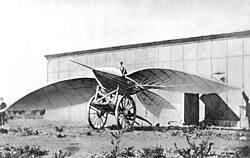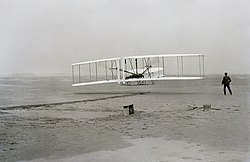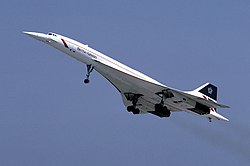Airplane

An airplane, also known as an aeroplane or just plane, is a fixed-wing aircraft. It moves by thrust from a jet engine, propeller, or rocket engine. Airplanes come in many shapes and sizes. The use of aircraft is called aviation. Airplanes are used for many things including recreation, transportation of goods and people, military, and research.
They can move much faster than road (such as cars, buses, motorcycles, off-road vehicles, light trucks, medium trucks and heavy trucks), rail (such as trains or trams) or sea transport (such as boats, ships, and submarines), and so they are often the choice for long distances. Many long distance airplanes are bigger than others because they need to carry more fuel.
Commercial aviation transports more than four billion passengers annually on airliners. Cargo aircraft carry more than 200 billion ton kilometres of cargo every year, which is less than 1% of the world's cargo movement. Most airplanes are flown by a pilot on board the aircraft, but some are airplanes made to be remotely or computer-controlled such as drones.
Airplanes fly between many cities all over the world, carrying people and cargo. Big cities usually have an international airport, where large airplanes can land and take off safely. Some large cities like New York City and London have more than one airport. Two major makers of airplanes are Airbus and Boeing.
Statistics show that riding in a plane is safer than driving in a car.[1]
Food
People make jokes about airline food, because they say it tastes bad.[2] While travelling on an airliner at a high altitude, it can cause dryness. Because of the low pressure, a person's taste buds are around 30% less sensitive to sweet and salty foods.[2]
Wings
The wings of a fixed-wing aircraft are static planes extending either side of the aircraft. When the aircraft travels forwards, air flows over the wings, which are shaped to create lift. This shape is called an airfoil and is shaped like a bird's wing.
Uses
Transport
Fixed-wing aircraft have long been used as airliners for moving passengers from place to place. Cargo aircraft carry cargo across seas and long distances, and passenger aircraft also carry some cargo.
War

The first aircraft for war bombing was used in Libya in 1911 by Italy against the Ottoman Empire (Italo–Turkish War).[3] Some fixed-wing aircraft are used by air forces to defend countries. These may be fighter aircraft, using guns or missiles for combat with other aircraft. They may be bombers, dropping bombs on ground targets.
Fixed-wing aircraft allow people to travel longer distances, and faster than ships or trains. Aircraft can fly from New York to London in about 7 hours. It would take one week or more on a ship. Militaries use airplanes to carry their soldiers quickly from place to place.
Airplanes are also used by the military to see many things on the ground easily. This is called surveillance or reconnaissance. Often, fixed-wing aircraft will take photographs as well, which can be used for military planning later. This role is now being taken over by drones, which are automatic planes.[4]
Impact
Fossil fuel-powered aircraft release soot and other pollutants into the atmosphere. They burn fossil fuel which releases CO2 emissions, and has warming non-CO2 effects due to nitrogen oxides (NOx), vapor trails and cloud formation.
Gallery
Airplane Media
Otto Lilienthal in mid-flight, Berlin, c. 1895
Patent drawings of Clement Ader's Éole.
The Wright Flyer's first flight on 17 December 1903
Santos-Dumont 14-bis, between 1906 and 1907
North American P-51 Mustang, a World War II fighter aircraft
American Airlines Boeing 737-800 landing at Ronald Reagan Washington National Airport in July 2024
The Concorde supersonic transport aircraft
Solar Impulse 1, a solar-powered aircraft with electric motors.
References
- ↑ Bailey, Joanna; Hardiman, Jake; Pickett, Riley (2022-09-08). "How Flying Today Is Safer Than At Any Time In The Past". Simple Flying. Retrieved 2023-07-24.
According to research by Harvard University, flying in the US, Europe, and Australia is actually significantly safer than driving a car. Your odds of being in an accident during a flight is one in 1.2 million, and the chances of that accident being fatal are one in 11 million. Your chances of dying in a car crash, conversely, are one in 5,000.
- ↑ 2.0 2.1 "Why does food taste different on planes?". BBC News. Archived from the original on March 8, 2023. Retrieved March 8, 2023.
- ↑ https://www.bbc.com/news/world-europe-13294524
- ↑ Long Flight Survive And Thrive On Your Journey - Airlinecalls. Archived 2024-11-10 at the Wayback Machine airlinecalls. 2006–2007 Session.














